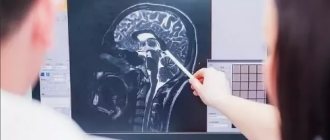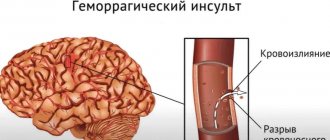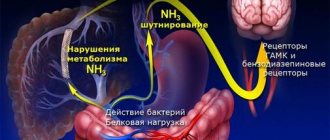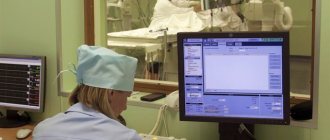Perinatal encephalopathy - symptoms and treatment
Treatment of perinatal pathology in the acute period is carried out in the neonatology department.
Surgical treatment may be necessary if the child has a large hematoma inside the cranial cavity; its removal is only possible through surgery.
With increasing closed hydrocephalus, in order to avoid brain atrophy from compression by fluid, children undergo shunt surgery - a shunt is installed (a plastic tube through which excess fluid from the cranial cavity is drained into the abdominal cavity and absorbed there).
However, most parents are faced with the need to treat a child with perinatal encephalopathy during the recovery period of up to 1 year due to impaired muscle tone, developmental delay, hypertensive-hydrocephalic syndrome and other manifestations.
The greatest effect can be achieved using an integrated treatment approach.
Therapeutic medical massage is carried out to normalize muscle tone and improve trophic processes in tissues. Should only be performed by a massage therapist with medical training and experience working with children with perinatal brain damage. The procedure is carried out in children's clinics and rehabilitation centers [3][5][7].
Exercise therapy - physical therapy. May include various types:
- Vojta therapy;
- Bobat-terpiya;
- therapeutic exercises on balls;
- mechanotherapy (exercise exercises on a simulator);
- classes with an instructor in the swimming pool.
Exercise therapy should only be carried out by an instructor with special education [6][7][18].
Microcurrent reflexology (MCRT) is a new medical technology approved by the Ministry of Health of the Russian Federation and recommended for the treatment of children with organic brain damage, delayed motor, speech, mental development and cerebral palsy. Treatment is carried out on an outpatient basis in rehabilitation centers in various regions of the Russian Federation.
The therapeutic effect is physiological and painless, using currents in the microampere range on neuroreflex zones in various areas of the skin. Microcurrents are 10 times less than with standard physiotherapy. Treatment is carried out according to an individual scheme, taking into account all the manifestations of perinatal encephalopathy present in the child.
During the treatment process, normal reflex activity of the brain is restored, muscle tone is normalized: spastic (tense) muscles are relaxed, hypotonic (weak) muscles are stimulated. MPRT stabilizes cerebral vascular tone, which allows compensation of intracranial pressure.
The method promotes the acquisition of new motor skills by restoring the activity of neurons in various areas of the cerebral cortex and cerebellum affected by hypoxia and hydrocephalus [4][6][9][14][15].
Medicines of the nootropic group (Cortexin, Pantogam, Ceraxon, etc.) should be prescribed only by a pediatric neurologist strictly according to indications, i.e., if the child has delayed psychomotor development and there are no contraindications [11][16].
diuretics only when intracranial pressure increases (expansion of the cerebrospinal fluid spaces on the NSG, the presence of clinical manifestations of hypertensive-hydrocephalic syndrome).
Pediatric neurologists, as a rule, prescribe the diuretic drug Diacarb, which also has an additional effect on the choroid plexuses of the brain - it reduces excess formation of cerebrospinal fluid and reduces intracranial pressure. However, it should be used only in combination with Asparkam, since the use of this diuretic leads to the loss of such a trace element as potassium, Asparkam replenishes its loss [16]. In mild cases in infancy, it is advisable to use gentle herbal preparations: fennel tea, dill water, approved for use in childhood.
The danger of perinatal encephalopathy
Like many other infant diseases, if not cured in the early stages, perinatal encephalopathy progresses with age and can manifest itself in the form of a wide variety of disorders that at first glance seem unrelated:
- frequent morbidity syndrome. These can be either frequent colds or periodic ailments associated with poor health, increased fatigue, headaches, etc.;
- chronic diseases of the respiratory system. They can manifest themselves against the background of frequent acute respiratory infections, gradually turning into a chronic form. In the absence of competent osteopathic treatment, with age they can develop into asthma and other equally dangerous diseases;
- developmental delay. They may manifest themselves in a less obvious form as learning difficulties, especially in the exact sciences and creative disciplines;
- posture disorders. Unnoticeable birth injuries and disturbances in the functioning of the central nervous system, which arose during pregnancy, often later lead to curvature of the spine and the appearance of such serious diseases as scoliosis, with all the ensuing consequences, leading to the prolapse of internal organs and their partial or complete dysfunction;
- disturbances in the functioning of internal organs, the metabolic system and the circulatory system. Typically, these disorders invariably lead to other diseases, since due to impaired blood flow, various parts of the body begin to receive less oxygen, which leads to cell death and dysfunction.
Degrees of severity and characteristic symptoms
Hypoxic-ischemic encephalopathy has 3 degrees of severity, which are characterized by their own manifestations. Using them, doctors often give a preliminary description of brain damage and an approximate prognosis.
Mild degree
With this degree the patient will have:
- the pupil is dilated and the eyelids are wide open;
- lack of concentration;
- impaired coordination of movements, wandering behavior;
- either drowsiness or hyperexcitability was detected;
- high degree of irritability;
- lack of appetite;
- cerebral circulation is impaired.
Average degree
Neurology with it will be more pronounced, since the disturbance in oxygen saturation of the brain is longer lasting:
- the baby has spontaneous cries for no reason;
- the protective and support reflex is either weakened or absent altogether;
- signs of muscle weakness;
- drooping upper eyelid;
- increased cerebrospinal fluid pressure;
- metabolic acidosis of the blood;
- neuralgic attacks;
- failure in the swallowing process.
Severe degree
The damage in such cases is more severe, which manifests itself in:
- convulsions;
- bluish skin;
- loss of consciousness;
- hypertension;
- lack of motor abilities;
- strabismus;
- coma or precoma;
- lack of pupil reaction to light;
- failure of the respiratory process with severe arrhythmia;
- tachycardia.
PEP is a type of hypoxic-ischemic encephalopathy in young children. It is diagnosed both immediately after birth and in the first year of life. PEP develops both in utero, during labor, and in the first 10 days from birth.
It can be of three degrees of severity with characteristic symptoms and occur in an acute form - up to a month, with early restoration of functions - up to 4 months, with late recovery - up to 2 years.
- Arthritis 3 degrees
How is perinatal encephalopathy diagnosed in newborns and infants?
There are a number of safe brain imaging techniques that newborns can undergo. They allow you to create a complete clinical picture, determine the presence of the disease, its degree, and the nature of its course. The most informative and effective is neurosonography, which accurately detects the presence of damaged areas in the baby’s brain. In addition to this, Doppler ultrasound can be performed to assess blood flow in the vessels of the brain.
If developmental abnormalities are detected, it is recommended to undergo an electroencephalographic examination aimed at determining the degree of developmental delay. This procedure also allows you to identify foci of epileptic lesions and assess the degree of their activity and danger to the body.
In some cases, an examination by an ophthalmologist is also recommended, who will help determine the extent of the damage by assessing the condition of the optic nerves and analyzing the fundus.
Treatment of encephalopathy with osteopathic methods
A good osteopathic doctor is able to diagnose early symptoms of the disease and create a complete picture of its course. This makes it possible to prescribe competent treatment that helps the body adapt to new conditions, launch and stimulate its self-regulatory functions.
The effects of an osteopath - depending on the course and complexity of the disease - are directed primarily to the affected areas of the body in order to relieve pain and spasms resulting from improper development and disturbances in the circulatory system. In parallel with this, the specialist carries out a set of procedures to normalize brain function. Usually, various techniques of muscular-energetic influence are used for this, which allow manually restoring the balance of tension in the intracranial membranes. This helps restore micropulsations in the bones of the skull and the brain itself, and normalize blood circulation.
After normalization of brain activity, the body receives a powerful incentive to self-regulate and get rid of encephalopathy. The osteopath's further actions are to help the baby's body cope with the disease. For this purpose, manual therapy, massage, physical therapy and other techniques are used, which, in the opinion of a specialist, can help a speedy recovery.
As practice shows, perinatal encephalopathy in newborns is completely cured in 30% of cases - with early detection and proper treatment. In another 20-30% - usually in severe and moderate cases - newborns are not completely cured. Some symptoms remain, but often some of them can be corrected with complex therapy, including exercise therapy, osteopathy, massage techniques, and special education, training, etc.
Unfortunately, in many cases when perinatal encephalopathy manifests itself in the form of serious damage to the cells of the cerebral cortex, it is impossible to get rid of the disease. The reason is the death of brain cells and disruption of neural connections, which cannot be restored due to the lack or absence of physical carriers in the child’s brain. Even in these cases, osteopathy can help relieve some neurological symptoms, but complete restoration of brain activity is impossible.
It is important that possible neonatal encephalopathy is diagnosed at the earliest stages of development - in the first months of a child's life. To facilitate this, it is recommended to visit an osteopath at 3 months of life for a full examination. The specialist will prescribe the necessary tests and conduct an independent examination, which together will help detect symptoms and identify the possible presence of the disease.
Often, when PEP is detected, pediatricians advise starting drug treatment. Moreover, this must be done from early infancy. Every parent should be aware that this approach is not always effective and can most likely harm the child. The fact is that the newborn’s body is quite weak, but at the same time it is balanced and capable of adaptation and self-regulation. Exposure to potent drugs leads to irreversible changes that even an osteopath cannot neutralize. Therefore, if a child is diagnosed with perinatal encephalopathy or there is serious suspicion of its presence, it is recommended to also undergo examination by an osteopath. Osteopathic techniques are more subtle and delicate, and therefore more effective. They have a targeted effect on areas of the body and brain, the nervous system of the child, bringing it to a normal state.









